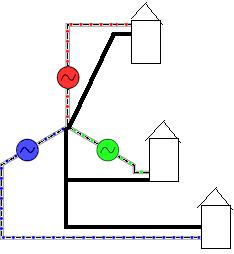Although I understand some of the practical side of electrics on an amateur basis I notice my head shies away from ideas around 'earth' and 'neutral' and AC power distribution, give me a battery and all is clear -point me at what comes out of the ground in my understairs cupboard and the theory of it sort of makes my brain jitter a bit and then reboot. So, with the attitude that learning is good...
Correct me when I go wrong but I've been trying to understand how things work: If I understand it tight both earth and neutral are essentially physically tied to the ground beneath my feet, the difference being earth is relatively local to my house but neutral may be connected to dirt anywhere between my TV and Drax depending on what the supplier does. Neutral may not be at the same potential as my earth because its physically connected to earth at a different location.
*If* the above is more or less right it begs the question - why do we have neutral at all? Why wouldnt every property have a big earth spike, connect all CPCs to the earth and also connect all current neutral connections to it as well.
I guess I am touching on the same question as "why do we have different supply types" which would probably explain much of what I've been pondering.
Correct me when I go wrong but I've been trying to understand how things work: If I understand it tight both earth and neutral are essentially physically tied to the ground beneath my feet, the difference being earth is relatively local to my house but neutral may be connected to dirt anywhere between my TV and Drax depending on what the supplier does. Neutral may not be at the same potential as my earth because its physically connected to earth at a different location.
*If* the above is more or less right it begs the question - why do we have neutral at all? Why wouldnt every property have a big earth spike, connect all CPCs to the earth and also connect all current neutral connections to it as well.
I guess I am touching on the same question as "why do we have different supply types" which would probably explain much of what I've been pondering.



